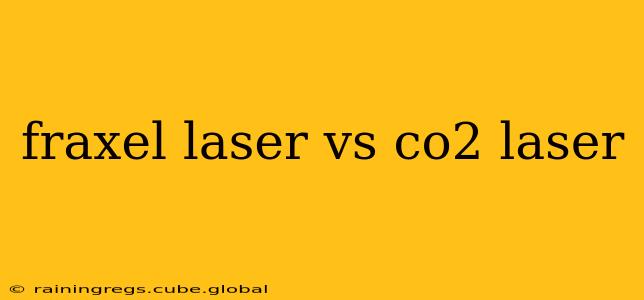Choosing between a Fraxel laser and a CO2 laser for skin resurfacing can feel overwhelming. Both treatments offer impressive results in addressing various skin concerns, but they differ significantly in their approach and recovery time. This comprehensive guide will delve into the key differences between Fraxel and CO2 lasers, helping you make an informed decision.
What is Fraxel Laser Treatment?
Fraxel lasers use fractional technology, meaning they target only a fraction of the skin's surface at a time. This approach creates microscopic zones of treatment, leaving healthy skin untouched. This "fractional" resurfacing promotes faster healing and minimizes downtime compared to traditional CO2 laser treatments. Fraxel lasers are versatile, addressing various concerns like wrinkles, acne scars, sun damage, and age spots. Different Fraxel laser types exist, with varying wavelengths and energy levels to customize treatment to individual needs.
What is CO2 Laser Treatment?
CO2 lasers, on the other hand, utilize a more aggressive approach. They ablate (remove) a larger portion of the skin's surface, resulting in significant skin resurfacing. This aggressive approach leads to more dramatic results but also significantly longer recovery times. CO2 lasers are effective for addressing deeper wrinkles, severe acne scarring, and significant sun damage. While incredibly effective, the extensive downtime and potential for complications make it a less suitable option for many patients.
Fraxel Laser vs. CO2 Laser: Key Differences
| Feature | Fraxel Laser | CO2 Laser |
|---|---|---|
| Treatment Depth | Superficial to deep, depending on the type | Deep |
| Recovery Time | Minimal to moderate (days to weeks) | Significant (weeks to months) |
| Downtime | Relatively short | Extensive |
| Pain Level | Mild to moderate | Moderate to severe |
| Cost | Generally less expensive | Generally more expensive |
| Side Effects | Minimal, typically redness and swelling | More pronounced, including swelling, blistering, and scarring (rare but possible) |
| Ideal For | Fine lines, wrinkles, acne scars, sun damage | Deep wrinkles, severe acne scarring, significant sun damage |
What are the Benefits of Fraxel Laser Treatment?
- Shorter recovery time: You'll be back to your normal routine much sooner.
- Less pain: The treatment is generally less painful than CO2 laser resurfacing.
- Lower risk of complications: The fractional approach minimizes the chance of side effects.
- Versatility: Suitable for a broader range of skin concerns.
What are the Benefits of CO2 Laser Treatment?
- Dramatic results: CO2 lasers offer the most dramatic skin resurfacing results.
- Effective for severe concerns: Ideal for deep wrinkles and severe scarring that Fraxel might not fully address.
Which Treatment is Right for Me?
The best treatment depends on your individual needs and skin type. Factors to consider include:
- Severity of skin concerns: For mild to moderate issues, Fraxel is often a better choice. For severe concerns, CO2 might be necessary.
- Desired results: If you need dramatic improvement, CO2 may be preferred, but you should be prepared for a longer recovery.
- Downtime tolerance: Consider your lifestyle and how much downtime you can afford.
- Budget: CO2 laser treatments are generally more expensive.
Consult a dermatologist: A qualified dermatologist will assess your skin and discuss your goals to determine the best treatment option for you. They can explain the risks and benefits of each procedure in detail.
What is the Recovery Time for Fraxel Laser Treatment?
Recovery time varies depending on the type of Fraxel treatment and the individual. Generally, you can expect some redness and swelling for a few days to a week. Some patients experience mild peeling or flaking. Most people can return to work or social activities within a few days.
What is the Recovery Time for CO2 Laser Treatment?
CO2 laser recovery is significantly longer. You'll likely experience significant swelling, redness, and peeling for several weeks. Crusting and scabbing may also occur. Complete healing can take several months, and it's crucial to follow your dermatologist's post-treatment instructions carefully.
Are There Any Side Effects?
Both Fraxel and CO2 laser treatments carry potential side effects, though they are less common with Fraxel. Possible side effects include:
- Redness and swelling: This is common and usually resolves within a few days or weeks.
- Pigmentation changes: Hyperpigmentation (darkening) or hypopigmentation (lightening) is possible, especially with CO2 lasers.
- Infection: Infection is rare but can occur with any skin procedure.
- Scarring: Scarring is a rare complication, particularly with CO2 lasers.
This information is for general knowledge and does not constitute medical advice. Always consult a qualified dermatologist for personalized guidance and treatment recommendations.
